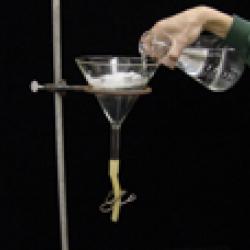Source Institutions
Source Institutions
Add to list Go to activity
Activity link broken? See if it's at the internet archive

This lesson introduces learners to the world of nematodes (roundworms). Learners construct Baermann funnels to extract nematodes from soil and learn to differentiate stylet-bearing nematodes (most likely plant parasites) from free-living nematodes. This lesson includes background information, study questions with answers for learners, and diagrams. Dissecting and compound microscopes are required (not included in cost of materials).
- Under 5 minutes
- 1 to 7 days
- $1 - $5 per group of students
- Ages 14 - 18
- Activity, Experiment/Lab Activity, Lesson/Lesson Plan
- English
Quick Guide
Materials List (per group of students)
- conical glass (preferably) or plastic funnel, at least 100 mm in diameter
- ring stand (to hold funnel)
- flexible rubber or plastic tubing
- spring-action hose clamp
- circular piece of wire screen to fit inside top of funnel
- 2-ply facial tissue (without moisturizing lotion)
- Pasteur pipettes and bulbs
- petri plate or watch glass
- microscope slides and cover slips
- clear nail polish
- alcohol lamp
- stereomicroscope (dissecting microscope)
- compound microscope
- freshly collected soil, preferably from forest floor or garden
Subjects
-
Life Sciences
-
Diversity of Life
- Plants
- Animals
- Viruses and Bacteria
- Protists and Fungi
- Classification
- Ecology
-
Diversity of Life
-
The Nature of Science
-
The Scientific Process
- Conducting Investigations
- Formulating Explanations
-
The Scientific Process
Informal Categories
- Animals
- Nature and Environment
Audience
To use this activity, learners need to:
- see
- touch
Learning styles supported:
- Involves hands-on or lab activities
Other
Components that are part of this resource:
- Purpose and Background Information
- Materials and Methods
- Lesson Plan
- Supplemental Information and References
- Diagrams
This resource is part of:
Access Rights:
- Free access
By:
- Tylka, Gregory L. ; Jasalavich, Claudia A.
Rights:
- All rights reserved, The American Phytopathological Society, 2011
